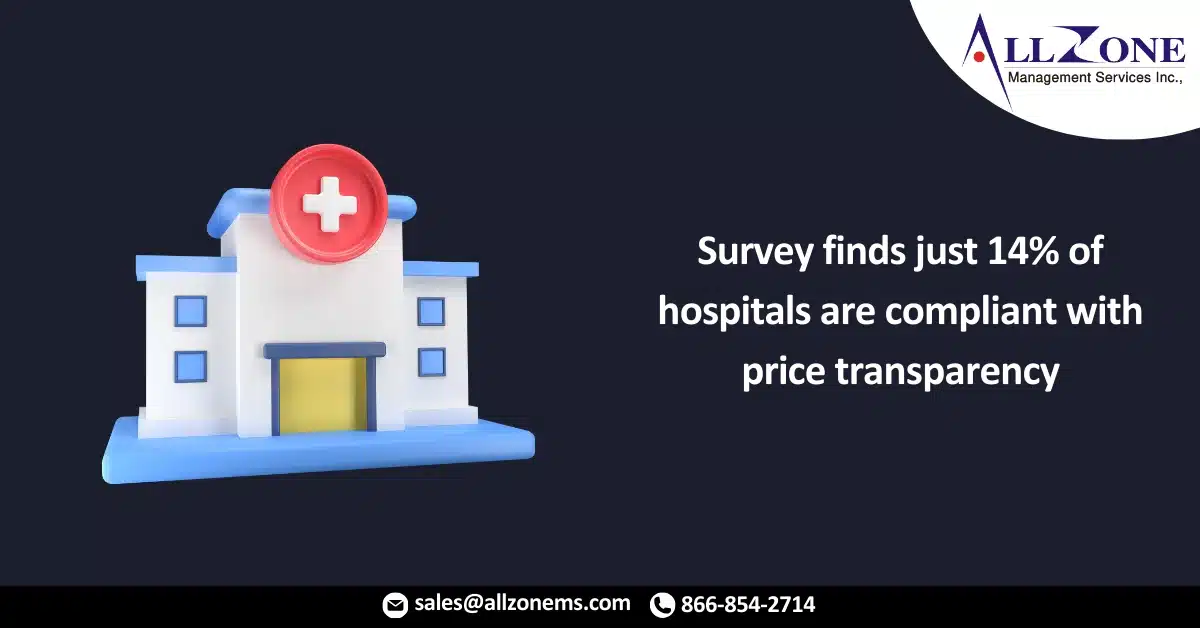The biggest noncompliance was non-posting or incomplete posting of all of the negotiated prices for each item and service.
In a federal price transparency rule that took effect January 1, 2021, hospitals were tasked with posting all of their prices online in clear, easily accessible formats. But a new survey from patientrightsadvocate.org has found that, to date, just 14.3% of 1,000 hospitals are compliant with the rule.
About 38% of the hospitals surveyed posted a sufficient amount of negotiated rates, but over half were not compliant in other criteria of the rule, such as rates by each insurer and named plan.
At the same time, just 0.5% of hospitals owned by the three largest hospital systems in the country – HCA Healthcare, CommonSpirit Health, and Ascension – were in compliance.
Just two of the 361 hospitals owned by these three hospital systems were compliant with the rule. For HCA Healthcare, the largest for-profit hospital system in the country, none of its 188 hospitals were in compliance. In 2021, the three systems’ combined total revenue approached $120 billion, while the cost of compliance calculated in the rule is just $12,000 per hospital, according to the report.
The most prevalent omission tagged as “noncompliance” was non-posting or incomplete posting of all of the negotiated prices for each item and service clearly associated with all of the payers and plans accepted by the hospital.
WHAT’S THE IMPACT
Almost 86% of all hospitals in the survey did not post a complete machine-readable file of standard charges, which is a requirement under the price transparency rule. A similar number, about 85%, failed to provide the national drug codes and associated prices for each of the drugs and pharmacy items offered.
Meanwhile, 62.1% did not publish a sufficient amount of negotiated rates; 58.6% did not publish all payer-specific negotiated charges “clearly associated with the names of each third-party payer and plan” as required by the rule; 26.2% did not publish any discounted cash prices; and 4.1% did not post any standard charges file.
The survey also reviewed each hospital for compliance with the requirement to publish 300 shoppable procedures and services displayed in either a consumer-friendly list or a price estimator tool. It estimated that 28.7% of hospitals presented 300 shoppable services in a consumer-friendly display for customary charges, but 216 remain noncompliant because their standard charges files were incomplete.
Close to 85% published a price estimator tool. Out of these, 20.4% did not allow uninsured patients or those seeking to self-pay to see the discounted cash prices – in violation of the regulatory requirements.
The rule established penalties for noncompliance at $300 per day for hospitals with less than 30 beds, and $10 per bed per day for hospitals with 31 or more beds, to a maximum daily penalty of $5,500. Currently, though, no hospitals have been reported to be issued a penalty for noncompliance by the Department of Health and Human Services.
The survey authors contend that although the Biden administration increased civil monetary penalties for noncompliant hospitals in November 2021, the penalties may not have been set at an adequate level for fully incentivizing compliance. Improved enforcement efforts and potential public disclosure of noncompliant hospitals are likely to positively impact compliance, the survey noted.
They argued that clear pricing data standards are needed.
In their view, implementing clear pricing standards – including uniform data file standards – will enable more efficient and reliable compliance audits, and likely better serve the intent of the rule by enabling technology innovators and search engines to design online shopping tools and other services that will foster price comparison and competition.
“Price transparency is a crucial first step toward a more transparent, competitive healthcare system,” the authors wrote. “Today, because of hidden prices and the lack of a functional market, the United States is paying double that of other developed countries for our healthcare, and with worse health outcomes and shorter life spans. Competition lowers costs of care to employers and workers, allows for higher wages, and results in a more globally competitive U.S. economy. Only with true compliance with both price transparency laws and regulations will such long-term goals be realized.”
THE LARGER TREND
The results are in line with earlier findings, published in June 2021 in the Journal of the American Medical Association and the American Journal of Managed Care, showing that most hospitals are not compliant with the price transparency rule.
JAMA’s report analyzed 100 random hospitals and found that 83 were noncompliant with at least one major requirement. Only 33 reported payer-specific negotiated rates and 30 reported discounted cash prices in a machine readable file.
Hospitals must display price data, including expected out-of-pocket costs, for shoppable services that can be scheduled in advance in a consumer-friendly manner that facilitates hospital comparisons.
The penalty for noncompliance is a maximum of $300 per day, but the JAMA study said that the cost of disclosure of negotiated rates could be greater than any fines.
The American Hospital Association has argued that the disclosure of privately negotiated rates does nothing to help patients understand what they will actually pay for treatment. It also accelerates anti-competitive behavior among commercial health insurers and hinders innovations in value-based care delivery, the AHA said.
For More Information: Survey finds just 14 hospitals are compliant price transparency

